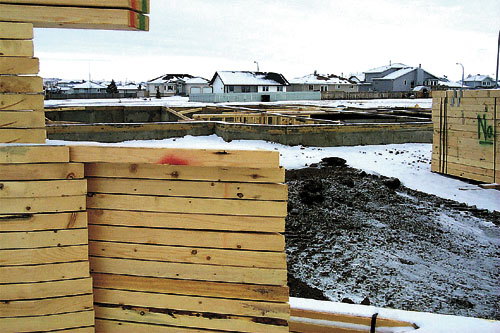Town Building Permits Drop 50 Percent Wood awaits workmen after a basement is dug for a new house in the northeast part of town. ©Provost News Photo. |
. . . but Dollar Spending Up The number of building permits have been on the way down for the years 2000 and 2001 compared to 1999. The amount of money spent on various projects however has actually increased, according to the Town of Provost’s chief administrative officer. Terry Hurlbut gave figures to The News that showed there were 36 permits issued in the town during 1999; 30 in 2000; and a drop of 50 percent in 2001 to 15. The total dollars spent on projects that required building permits jumped in 2001 mainly due to the new town office valued at $500,000. Housing showed the biggest drop from 2000 to 2001 with only one residence and two private garage permits issued that year while in 2000 Hurlbut said there were approximately five house permits issued. Here’s a snapshot of building activity in the town for the last three years (the listing “community” could include town projects such as sports facilities like tennis courts or for last year the town office): |
Similar numbers are not available from the M.D. of Provost No. 52 because they do not issue building permits. Utilities and development officer for the M.D. of Provost, Calvin Symington said in a telephone interview that people do however require building permits and they have a list of 16 agencies that a builder can contact to obtain one. Symington added that he can however issue development permits. Their main intention is to alert neighbours that a development may take place near them. Some projects though will not require a development permit, depending on the project and what district they are designated as being in (such as an agricultural district). An example of a development permit exemption would be a person owning a minimum of a quarter of land and they are putting up a structure such as a granary or a house. But a house being put up in the M.D. on a subdivision would require both a development and a building permit. Another example that may require an M.D. permit would be building within a hamlet. Symington said that there are other districts that require development permits. Generally oil and gas installations are exempt from the M.D.’s development permits. Oil and gas projects are subject to approval from the Alberta Energy Utilities Board—and in a few cases, some of those projects will need approval from the M.D. of Provost. |
|||